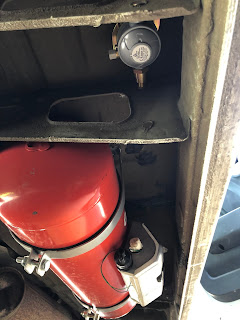The units were glued and screwed together and secured to the floor and walls of the van. We've fitted our cupboard hinges and doors (B&Q GoodHome Alpinia Shaker Style in Matt Ivory), and worktop (Ikea Ekbacken in Light Oak).

We've cut holes to accommodate our appliances, and sealed all the cut edges of the worktop with gloss varnish to waterproof.

We've installed the sink (Smev 928 round sink), tap (chrome with pull-out hose from eBay), drinking water tap (Comet London microswitched tap), and hob (NJ Domino-G LPG 2-burner hob in white glass)
The reason for the two taps is so that we have a dedicated drinking water tap supplied from a 15l plastic water carrier under the sink. This means if we are filling up the 100l underslung tank from a water source we are not 100% about the quality we can still have separate clean drinking water. It also means we can easily ask to fill up the small container from any pub/restaurant tap.
Another reason for the separate water system is that when we use the van in the winter and it's too cold for the underslung tanks and the water system is drained and winterised, we can still use the drinking water tap.

The worktop is fixed to the cupboards with lots of 90 degree brackets.
WOOOOO it looks like a kitchen!!
The gas was connected up to the hob and leak-checked... It works!




























